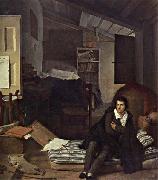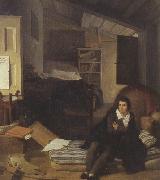|
Here are all the paintings of Tommaso Minardi 01
| ID |
Painting |
Oil Pantings, Sorted from A to Z |
Painting Description |
| 26990 |
 |
Self-Portrait |
mk52
c.1813
Oil on canvas
37x33cm,
Uffizi,Florence
|
| 22839 |
 |
Self-Portrait (mk22) |
1807
Oil on canvas,37 x 33 cm
Florence,Galleria d'Arte Moderna |
|
|
| Tommaso Minardi
|
| 1787-1871
Italian painter, draughtsman, teacher and theorist. He studied drawing with the engraver Giuseppe Zauli (1763-1822) who imbued Minardi with his enthusiasm for 15th-century Italian art and introduced him to his large collection of engravings after the work of Flemish artists such as Adriaen van Ostade. However, Minardi was strongly influenced by the Neo-classical painter Felice Giani, who ran a large workshop in Faenza, and whose frescoes of mythological scenes (1804-5) at the Palazzo Milzetti he saw being painted. In 1803 he went to Rome on an annual stipend provided by Count Virgilio Cavina of Faenza (1731-1808), and he received (1803-8) additional financial assistance from the Congregazione di S Gregorio. He was given the use of Giani's studio and through him met Vincenzo Camuccini who, with Canova, dominated the artistic establishment in Rome at that time. Although Minardi learnt the precepts of Neo-classicism from Camuccini, he did not share his interest in heroic art. His first works done in Rome show his interest in the theme of master and acolyte. In Socrates and Alcibiades (1807; Faenza, Pin. Com.), for example, he has included himself among a group of elderly philosophers and young students who are placed on either side of a portrait bust of Zauli. He sent this drawing to his patrons, the Congregazione di S Gregorio, no doubt to reassure them of his aptitude and moral correctness. Supper at Emmaus (c. 1807; Faenza, Pin. Com.) was another painting destined for the same patrons. The confined pictorial space, with a single source of light entering through a small window, and the casual poses of the figures are reminiscent of Flemish art and of the works of the northern Caravaggisti, familiar to the artist through engravings.
|
|


